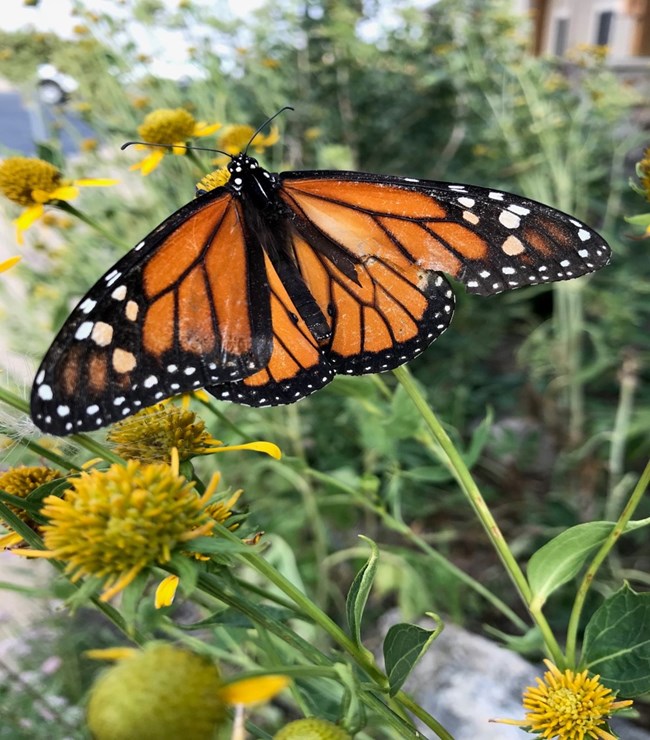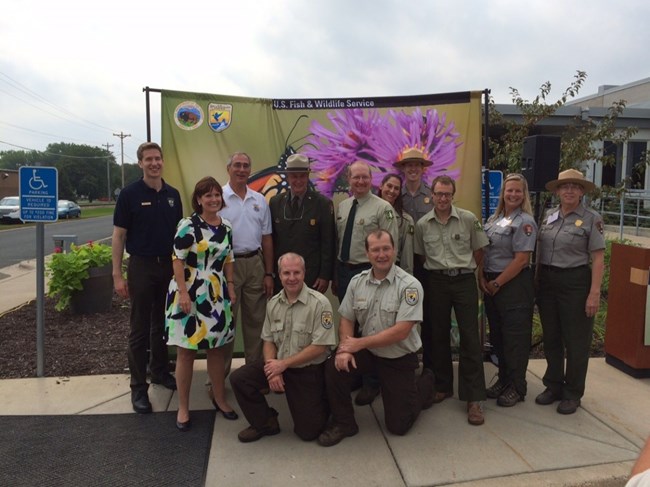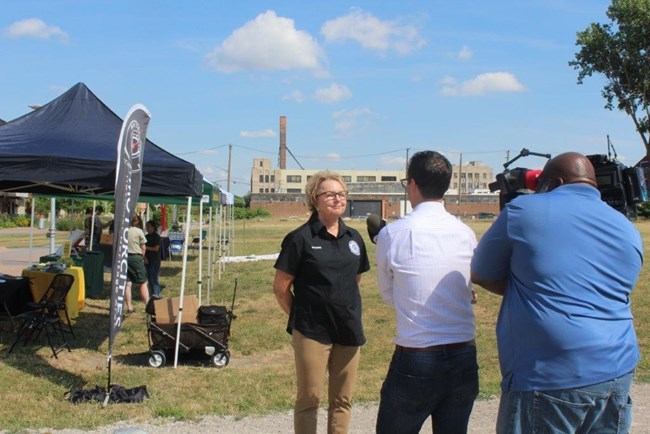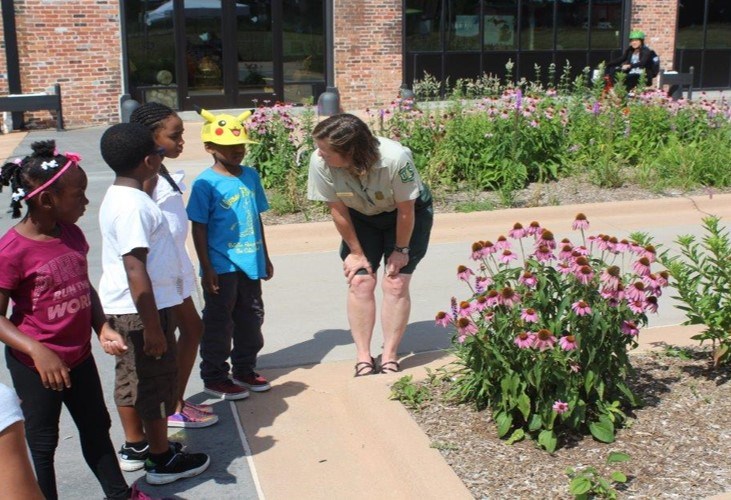Last updated: October 31, 2018
Article
Metamorphosis in the Midwest Region: the pollinator pledge takes flight

Photo courtesy of Chris Stein
St. Croix National Scenic Riverway is no stranger to being the first. After all, it was one of the first national river systems of its kind.
On Oct. 2, 1968, President Lyndon Johnson signed the Wild Scenic Rivers Act, including the St. Croix and Namekagon rivers among America’s first Wild and Scenic Rivers. Now, as we celebrate the 50th anniversary of the Act, St. Croix National Scenic Riverway (NSR) is serving as a model of what Christopher Stein, National Park Service (NPS) Midwest area Chief of Heritage Areas and Partnerships, hopes will be many public and private lands taking a pledge for pollinators.
“I have personally taken up the pollinator cause because it is meaningful work. Pollinators are a global issue. Every plant in the ground (pesticide free that is) can help their cause,” said Stein. “If you like to eat, then you should also help pollinators.”

Photo courtesy of Chris Stein
Yesterday’s Promise…
Stein’s work for pollinator conservation began during his time as Superintendent of the St. Croix NSR, located in the proposed North Woods and Waters of the St. Croix National Heritage Area, which encompasses the 8,000 square mile watershed of the St. Croix River.
“In 2015, the U.S. Forest Service, U.S. Fish and Wildlife Service, and National Park Service - the major federal land management agencies working within the St. Croix Valley - held a meeting to see where their interests overlapped,” Stein said.
With the Midwest being a “hot spot” for pollinator activity – particularly for the distinguishable monarch butterfly - pollinators presented a great opportunity for partnership.
“We signed what we believe and what we would work toward,” Stein said. “The pollinator pledge form commits us to doing something – as small as planting a garden to as big as restoring a prairie.”
Thus, that same year, the three agencies and their partnering organizations signed a resolution committing themselves to act for pollinators. The St. Croix Valley Pollinator Partnership officially formed in August 2015 with 75 organizations committing to the pledge and a celebratory event attended by federal officials and U.S. Congresswoman Betty McCollum.

Photo courtesy of Chris Stein
…Living on Today
Today, Stein’s new role is Chief of Heritage Areas and Partnerships for the NPS Midwest Region, but he has not forgotten his pledge. As if overseeing eight nationally important stories of the Midwest’s heritage isn’t enough, Stein’s ambition has undergone a metamorphosis, taking the pledge to new heights with the goal to protect, enhance, or restore pollinator habitat by using the monarch butterfly in the NPS Midwest Region as a flagship species.
“Protecting and increasing habitat will increase the monarch populations - which have declined 90 percent since the 1990s - and the populations of all pollinators,” Stein said.
This year, the hope is to expand the reach of what started as a localized pledge amongst three federal agencies and many partners along a stretch of Riverway. In fact, the initiative is already doing just that! This year, it is anticipated that several more Midwest Region heritage areas will sign their own pollinator resolution, as well as several more heritage areas from around the U.S.
“In 2018, three Midwest Region National Heritage Areas joined the St. Croix Pollinator Partnership and obtained pollinator pledges from their partners,” Stein said. “Gettysburg National Military Park and Eisenhower National Historic Site are the first national parks to sponsor their own Pollinator Resolution with just their primary not-for-profit partners.”
Abraham Lincoln NHA in Illinois, Northern Plains NHA in North Dakota, and MotorCities NHA in Michigan were the first NHAs to join in 2018. As far as partnering organizations, Stein’s pledge has been signed from a diverse groups in the St. Croix Valley - from local breweries to corporations like Xcel Energy. But whether a big or small organization, National Heritage Area (NHA) or national park, Stein wants prospective pledges to know that committing to pollinator conservation is easy. As far as partnering organizations, Stein’s pledge has been signed from a diverse groups in the St. Croix Valley - from a local yoga club to corporations like Xcel Energy. But whether a big or small organization, National Heritage Area (NHA) or national park, Stein wants prospective pledges to know that committing to pollinator conservation is easy.
“Only three steps,” Stein explained. “Draft your own pollinator resolution, you and your partners sign a Pollinator Pledge - that is, what activity you will do -, and put your pledge partner names on the back of your Pollinator Resolution and get widespread media attention!”
According to current pollinator partners, that really is all it takes - and the results are instantaneous.
“It’s already helped us connect with our natural resource partners,” said Shawn Pomaville-Size, executive director of Motorcities NHA in Michigan, one of the first to sign the pledge.
“While the additions of Silos and Smokestacks NHA in Iowa, Freedom’s Frontier NHA in Kansas and Missouri, and the Illinois and Michigan Canal NHA add 55,000 square miles to areas that could be converted to pollinator habitat, more than half a dozen other designated NHAs will likely sign their own Pollinator resolutions and pledges, potentially increasing more pollinator habitat in the states of New York, Connecticut, Massachusetts. Pennsylvania, Georgia, Mississippi, Alabama, New Mexico, Nevada, and Alaska,” Stein added. “The only way that this program is successful is when organizations (both public and private, both for profit and not for profit) commit to “do something” positive for pollinators on their lands....like plant milkweed or a nectar garden, restore prairie, or even educate the public about pollinators.”

Photo courtesy of Chris Stein
A challenge and a pledge
Collectively, the pollinator resolution that was initally signed in 2015 has now grown to over 200 organizations and counting in the Midwest and serves as a model for elsewhere. Stein continues to challenge public lands and their partners in the Midwest and beyond to take the pledge.
“Protecting and supporting pollinators and their habitat is a very simple thing for organizations to commit to do. In many cases, they are already doing something. In other cases, it doesn’t cost an extra cent to get involved (just some time)," he said.
Despite moving on in his career, the innovation and passion of Stein and others is evident still along the St. Croix Valley pollinator corridor. Here, more than 1,000 acres of habitat identified for restoration as part of their pledge has already undergone measure for improvement for pollinators, such as prescribed burning, invasive plant removal, and seed planting.
“Can you imagine if we all worked on a national conservation priority issue that really had the possibility of making a big difference? Well, we can. Please join the pollinator cause and feel like a bigger movement."
To join the movement, Stein invites those interested to contact him directly at chris_stein@nps.gov or call him at 402-881-1387.
